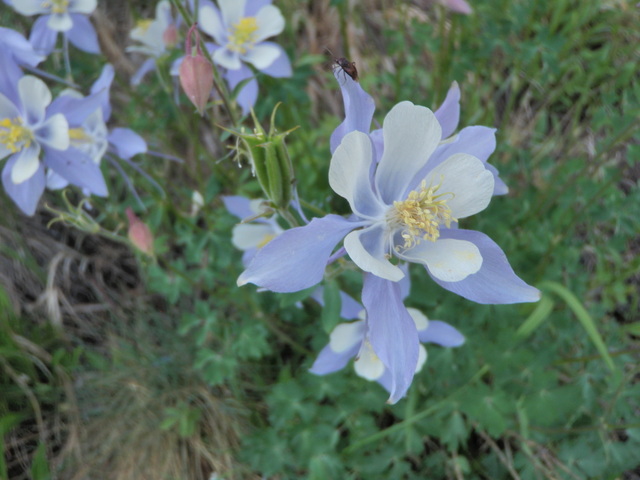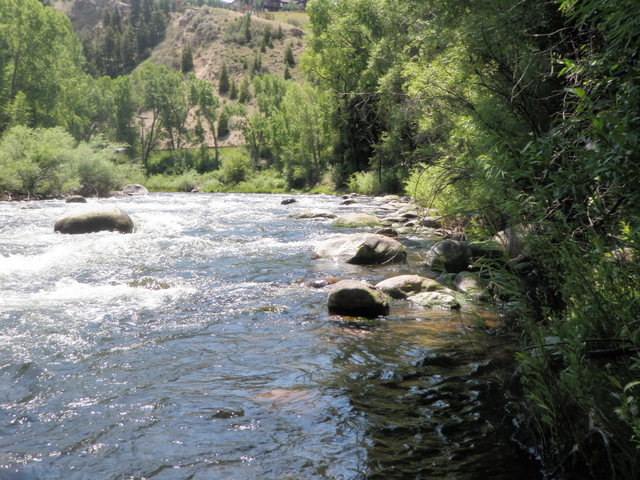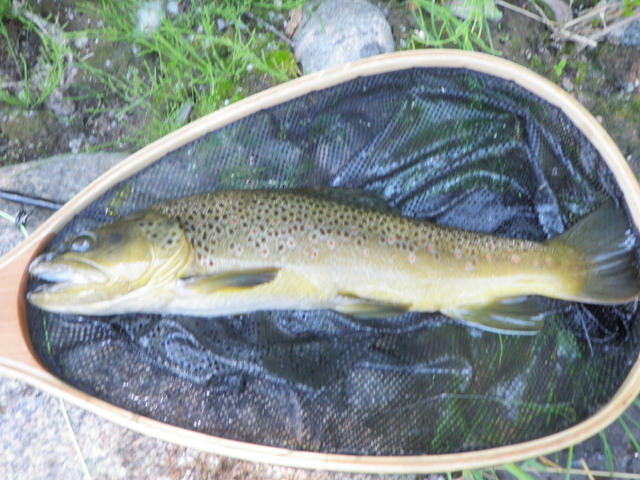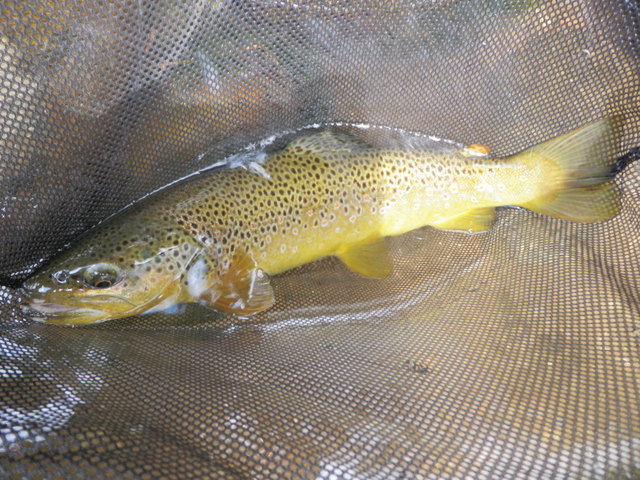Time: 9:30AM – 3:00PM
Location: Rest Area
Fish Landed: 6
Eagle River 07/10/2013 Photo Album
After experiencing an hour and a half of intense pocket fishing on Tuesday and then a nice hatch in the early afternoon, I was convinced that another interesting day of fishing on the Eagle River was in store on Wednesday so I returned to Hornsilver and snagged campsite number one for a second consecutive night. Aside from some rock climbing revelers that were partying at 1:30AM, the night was relatively uneventful, and I awoke to a moderately warmer morning. There was quite a bit of dew on my two person tent and I didn’t want to wait for it to dry, so I rolled up the tent and rain fly and stashed them in the back of the Santa Fe. Once again I ate my breakfast, prepared a sandwich for lunch and packed everything in the Santa Fe and drove for half an hour to the Edwards rest area.
My plan for Wednesday was to return to the water above the pedestrian bridge and cover sections that Dave G. and I visited on Friday. I wanted to save the pockets along the right bank above the pedestrian bridge that Dave G. covered on Friday for the prime time, 10:30AM until 2:00PM. With this strategy in mind I walked along the left bank above the bridge and around the 90 degree bend to the spot where the currents merge below the island. I tied on a Chernobyl ant, beadhead hares ear, and beadhead bright green caddis pupa with the hope of repeating my morning success of the previous day.
The angled riffles and run below the island did not produce any fish and as I moved into the smaller left channel it was obvious that the river flows had dropped significantly since the previous Friday. Deep runs had become shallow riffles and there were only three or four small deeper pools that might contain fish. I did manage to hook and land a small ten inch brown half way up the left channel.
At the top of the island the same lower stream level manifested itself, but this actually made wading easier and in the main channel of the river offered more obvious holding lies for fish. I was optimistic that I could take advantage of this and pop my three fly combination to the juicy pockets and deeper runs and land some nice fish. Unfortunately it didn’t develop that way. I covered the entire left bank above the island until I reached the point where a tiny branch of the river split off and ran back toward the top of the island with nothing to show for my enthusiasm and effort. I was astounded at my lack of action and also concerned about my prospects for the remainder of the day. In addition by 10:30AM it was already quite warm with very few clouds in the sky.
I used the small branch of the river as my escape route and waded back down to the island and then retreated back around the bend to the pedestrian bridge and crossed to the opposite side. It was now close to 11AM and I was positioned to fish the right bank pocket water during prime time just as I had planned. Between 11AM and 2PM I covered all the juicy pockets with initially the Chernobyl, hares ear, and caddis pupa. After not scoring any fish in the first couple of historically productive runs and pockets, I swapped the Chernobyl for a yellow Letort hopper since that worked in the past and I hoped it would mimic a golden stonefly.
Over the three hour period I managed to land four browns and several were in the 14-15 inch range, but it was very slow compared to my experience in previous years and also relative to the morning session in the pockets further down river above the highway bridge. When the hatch began at around noon, I exchanged the caddis for a beadhead pheasant tail and salvation nymph, but this didn’t seem to make a big difference. I did experience quite a few refusals to the hopper and had at least three foul hooked trout. This resulted from me seeing a swirl and setting the hook only to embed one of the trailing nymphs into the body of the interested fish. At least twice the victim trout shot into the fast white water and I let it run until it was below me and then in an effort to skip it back across the surface, the flies broke off.
By the time I reached the 90 degree bend at the top of the pocket water, small cream colored mayflies continued to emerge and caddis of varying sizes dapped the stream surface. In a wide riffle just above the bend I spotted a few rises even though the mayfly hatch was waning so I switched to a light gray deer hair caddis and shot a cast above the spot where a rise had been seen. Much to my surprise a fish gulped my fly and I set the hook and the brown instantly leaped and cleared its entire body above the water. It appeared to be in the 13-15 inch range but my hook released as the fish crashed back into the river. This renewed my enthusiasm so I continued prospecting the caddis to the head of the riffles with no additional success as the mayfly hatch disappeared and the caddis continued their surface dance.
At the head of the riffles I climbed up the bank to route 6 and hiked back through the condos and returned to the parking lot at the rest area. I decided to return to the spot near the parking lot where I’d spotted two browns on Tuesday afternoon after lunch, and sure enough after I arrived and observed for a bit, I spotted the upper fish doing its thing a foot below the surface and occasionally sliding from side to side to pick off something subsurface. I was unable to spot the lower brown so I focused on the upper fish. It was quite warm and the PMD hatch had ended so I decided to work this fish for awhile to see if I could find something to its liking.
I began with the caddis and on the fourth or fifth drift it rose and sipped my fly! I made a quick firm hook set and made contact for a split second, but then the brown slipped off. This was cruel luck for the fisherman. Would the big guy feed again? I rested the water and after a short time the brown began to exhibit its feeding actions by resuming its side to side movement. Over the next half hour I went through a host of flies; a yellow sally (because I noticed a few), a Chernobyl ant (the fish moved slightly to it the previous day), a lime green trude (small golden stonefly imitation), a yellow Letort hopper (larger golden stonefly imitation), and none were to the liking of the visible brown.
Finally I spotted a parachute ant in my patch so I decided to give it a try. This particular ant had fairly large bumps and an orange wing post. Much to my surprise the brown rose and put its nose against the ant, but it did not close the deal. My heart stopped and then I dropped into a state of frustration. I opened my foam patch and noticed I had a second parachute ant with a narrower body and a yellow poly wing post and it was the only other parachute ant in my patch. In a last ditch effort to entice the brown, I tied it on my line and flicked it above the brown. On the third drift the brown slowly swam to the surface and sipped it in! My opponent fought valiantly but eventually I slid the net underneath and had a 15 inch brown. I congratulated my adversary for being a noble foe, snapped a photo and revived him or her in the shallow slow moving water along the bank until it slowly swam back to its holding position. It was a great ending to a somewhat disappointing day on the Eagle River.




